

After its Final Destruction, Babylon of Chaldea, “will never be inhabited or lived in from generation to generation…” (Isa 13:19-20
THIS PROPHECY HAS NEVER BEEN FULFILLED!
(therefore, Babylon must Rise Again)
PHOTOGRAPHIC PROOF below
that Babylon of Iraq has had Inhabitants over the past 120 years
A 2500-year timeline document of Babylon's Inhabitants follows...
return to BABYLON REBUILT main article
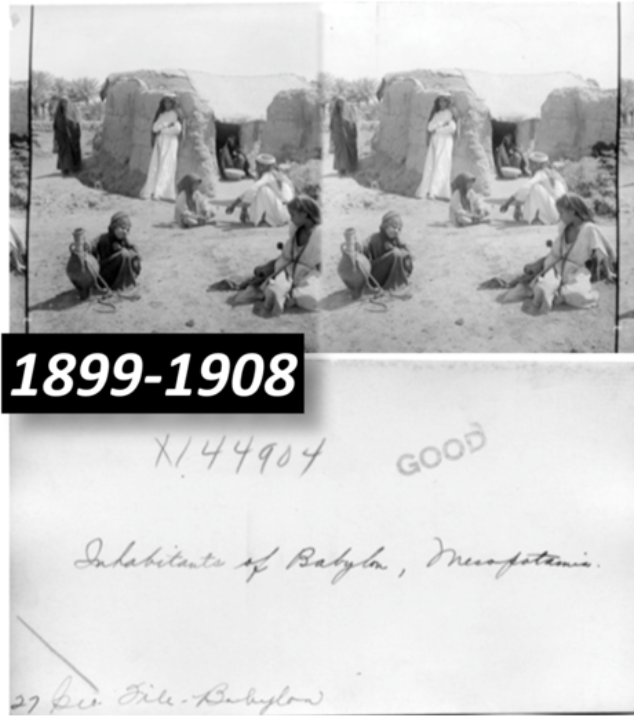
INHABITANTS AT BABYLON
RIGHT: A photograph of Inhabitants in Babylon of Chaldea, taken sometime between 1899 and 1908. The stereoscopic photo was designed for realistic viewing purposes.
The Title, Source & Official Archive Record is noted below:
Title-- "INHABITANTS OF BABYLON, MESOPOTAMIA"[actual, original inscription on back of photo, lower RIGHT]
Underwood & Underwood, stereoscopic photo, 1899-1908
UC Riverside, California Museum of Photography archives
[Location] Asia, Iraq, Babil, Latitude: 32 33 00 N, Longitude: 044 24 00 E, Babylon
EDITORS NOTE: These early-stage photographs were not taken in support of a Biblical agenda, but by secular sources-- explorers, archaeologists, and travelers-- with a focus on documenting the Middle East.
BELOW: A closer look at the inscription on the back of the photograph (magnified).

The IMPORTANCE of these PHOTOGRAPHS to the BABYLON of Prophecy...
1. There will be Absolutely NO Inhabitants AFTER the Final Destruction of Babylon of Chaldea (original Babylon in Mesopotamia, Iraq).
And Babylon... the Chaldeans' pride, Will be as when God overthrew Sodom and Gomorrah.
It will never be inhabited or lived in from generation to generation; (Isaiah 13:19-20; Jer 51:37, 62
2. Photographs, however, document that Inhabitants have resided-- and continue to reside-- at Babylon.
3. This is PHOTOGRAPHIC-PROOF that Babylon has NOT YET met its Final Destruction, and therefore MUST Rise Again.
Gertrude Bell & her remarkable early PHOTOGRAPHIC Record of Babylon
LEFT: Gertrude Bell, the traveler, explorer, archaeologist, and British diplomat. She became an expert in Middle Eastern history and culture, and a friend throughout the Arabian tribes, during the first decades of the twentieth century prior to and during World War 1. She was held in such high esteem by both the British and the Arabs that, like her friend and associate, T. E. Lawrence, "Lawrence of Arabia", she earned a similar accolade when her Middle Eastern friends began to call her "Queen of the Desert".
She was the only woman to serve, alongside Lawrence and Winston Churchill, at the Cairo Conference which was responsible for establishing the post-Ottoman Empire, post-World War 1 boundaries and political makeup of the Middle East.
Bell was an avid photo-documenter of her travels throughout the Mid-East. Her photographic record of Babylon of Chaldea is a priceless visual record of Babylon's place in Bible Prophecy (though that was not her purpose). Her hundreds of pictures of Middle Eastern places and people are stored in the
Gertrude Bell Archives
UNESCO ("Memory of the World")
Newcastle University,
Newcastle, United Kingdom
BELOW: The Cairo Conference of 1921. The people circled, left to right, are Gertrude Bell ("Queen of the Desert"), Winston Churchill (future British Prime Minister), and T. E. Lawrence ("Lawrence of Arabia").
FURTHER BELOW: The three are seen on a camel ride.
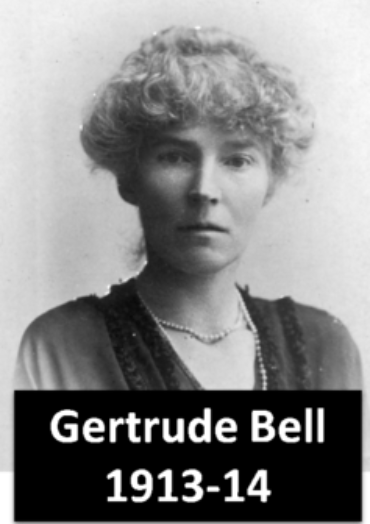
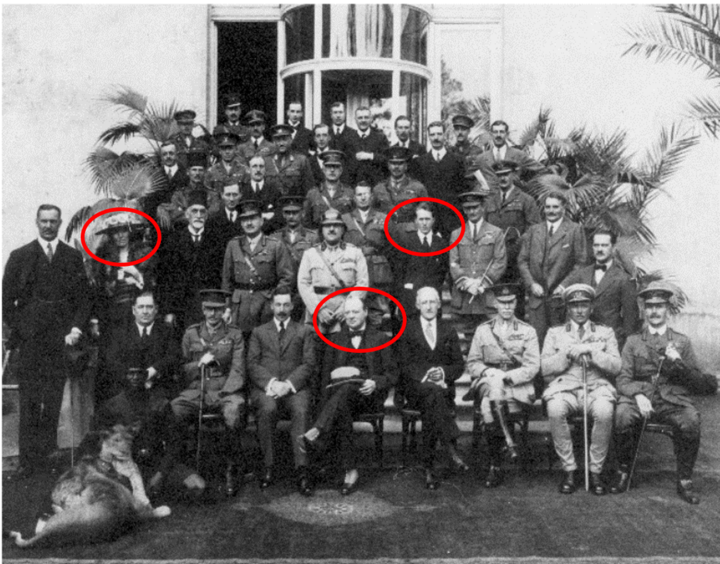
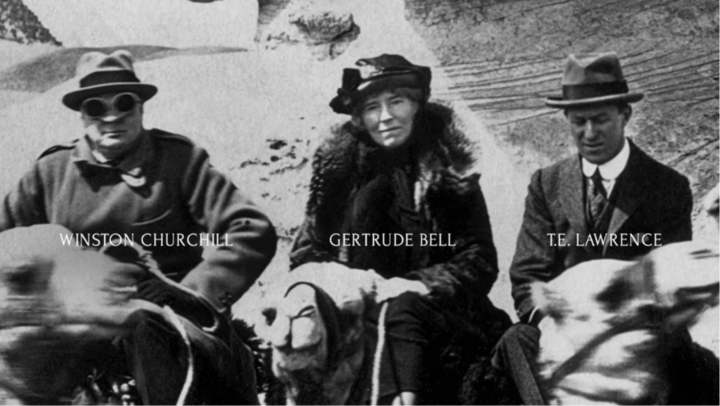
ABOVE: Like the photograph at the top of the page, Gertrude Bell's pictures were also well documented, and most of the documentation is included with her photos here and below.
Notice the location of these photos is Babylon, Iraq. Note that the archaeologist's headquarters further below is on the site of Babylon itself, and is surrounded by mature palm trees. It is an expansive dwelling and appears to pre-date the 1898-1918 occupancy by German archaeologist Robert Kodewey and his large team of associates and workers.
It was probably inhabited prior to becoming their residence, but regardless, it is certainly a fact that the Koldewey team were Inhabitants of Babylon for almost 20 years.

ABOVE: Archaeologist Robert Koldewey and associate directing the work of excavating Babylon of Chaldea (Iraq) in 1914. The many workers seen in the background had to live at Babylon to work at Babylon. There were the Arab villages within the boundaries of the Babylon excavation site-- Kweirisch, Ananeh, Sinjar and Jumjumma--from which many of these workers were recruited. They were indeed, Inhabitants of Babylon during the years surrounding 1914.
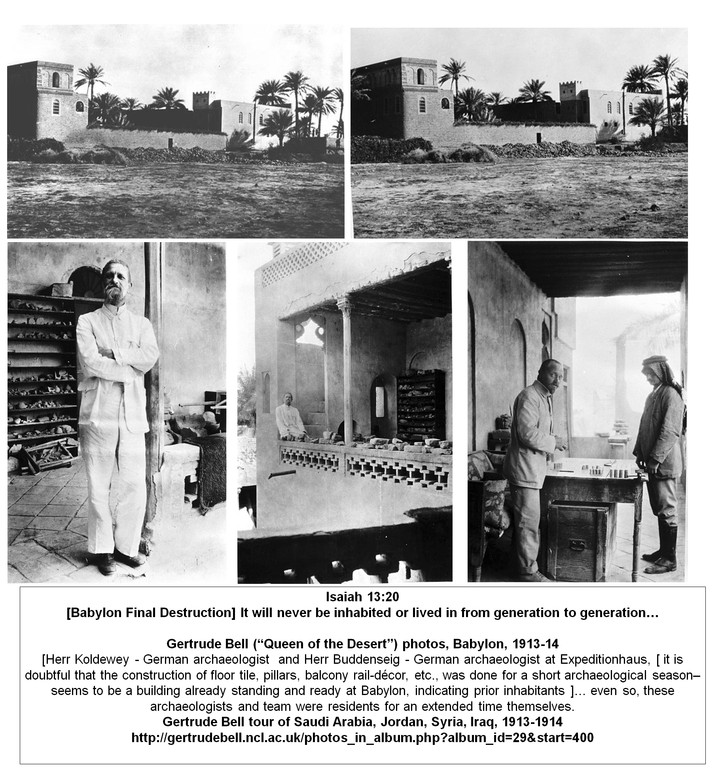
ABOVE: German archaeologist Robert Koldewey and his associate, Herr Buddenseig, at their Expeditionhaus on the grounds of Babylon in 1913-14 where Koldewey conducted his excavations. Koldewey and his team lived at Babylon during the 19 years of his work.
These photographs were taken by his visitor and friend Gertrude Bell. For 19 years they certainly qualified as Inhabitants of Babylon.

ABOVE: Associate archaeologist Beddenseig with helper at the Babylon Expeditionhaus in this 1914 photo taken by Gertrude Bell. Notice in this photo and the ones above that the Expeditionhaus has all appearances of having been on the grounds of Babylon for an extended time. The tree growth around the house, and the tile construction does not lend itself to a recent building, but rather a residence of earlier habitation.
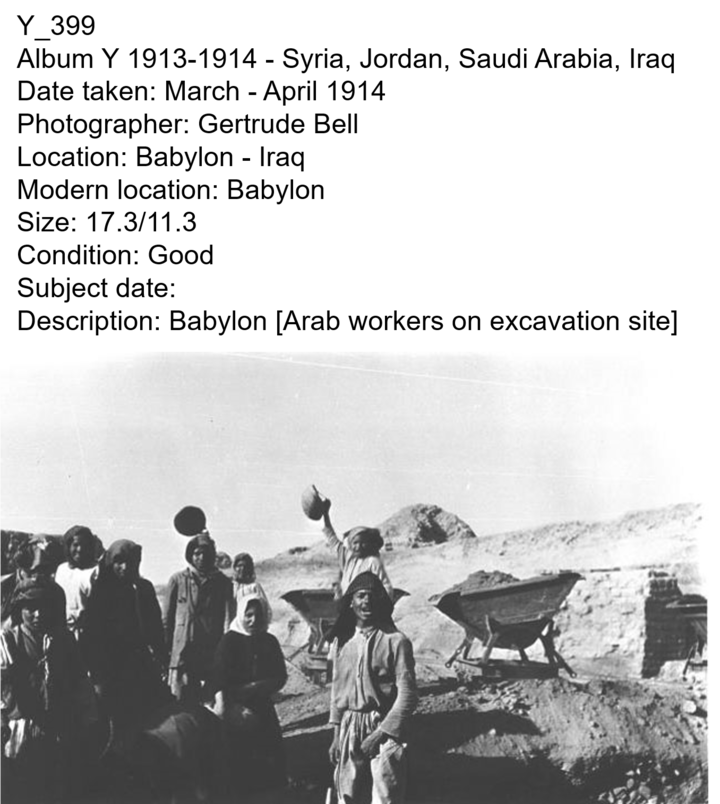
ABOVE & BELOW: Gertrude Bell's photographs taken in March-April, 1914 of workers at the digs of archaeologist Robert Koldewey. In the bottom photo one can count about 25 workers. They would undoubtedly have lived at Babylon in order to work there every day. (see further below, 250 workers)

BELOW: Archaeologist Robert Koldewey, in a page-shot of his 1914 book Excavations At Babylon, reports that as many as 250 workers reported DAILY for nearly 20 years (1899-1917) at the digs. These workers would have had to live on the grounds of Babylon to make that schedule on a daily basis.
Since they were primarily Arab workers, and since there were 4 active Arab villages on the grounds of the Babylon archaeologic site, there can be no doubt that they, for the most part, were inhabitants of these 4 villages at Babylon during the years 1899-1917, with many being permanent residents at Babylon both before and beyond those years.
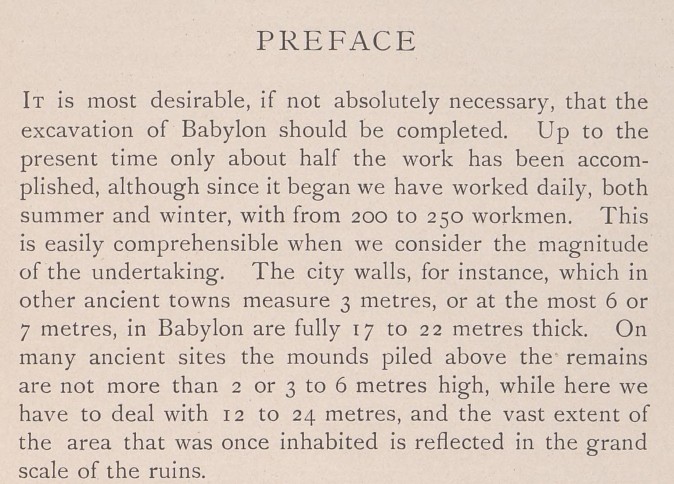
BELOW: Some of the 200-250 RESIDENT (INHABITANT)-workers at Koldewey's Babylon digs, 1899-1917. (see further below, TODAY'S INHABITANTS)
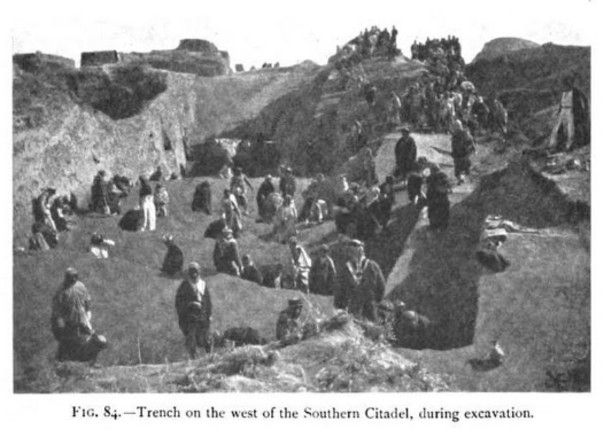
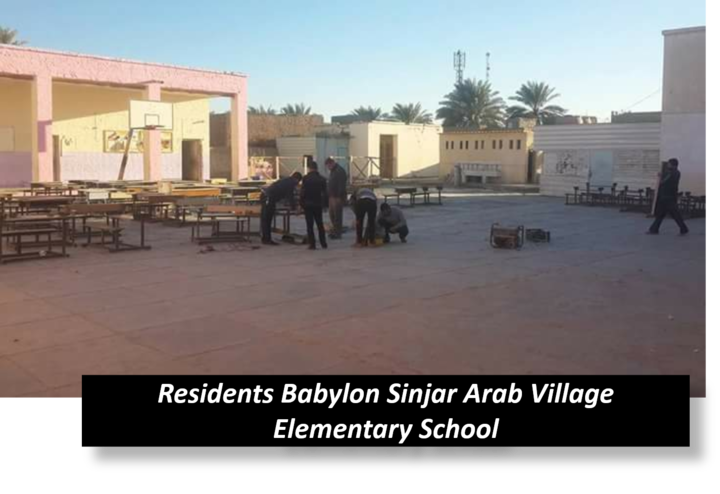
ABOVE: Employees working at the Sinjar Elementary School. The Arabic village of Sinjar has historic roots at Babylon, and is located within the archaeological parameters of ancient Babylon in Iraq. Sinjar residents are Inhabitants of Babylon today.

LEFT: This recent Alamy-Photo shows local inhabitants playing basketball in the Sadaam (Hussein) Palace located on the grounds of the original ancient city of Babylon. It is documented "that inhabitants live inside the boundaries of ancient Babylon's old city walls" TODAY!
(see Note #8 below)
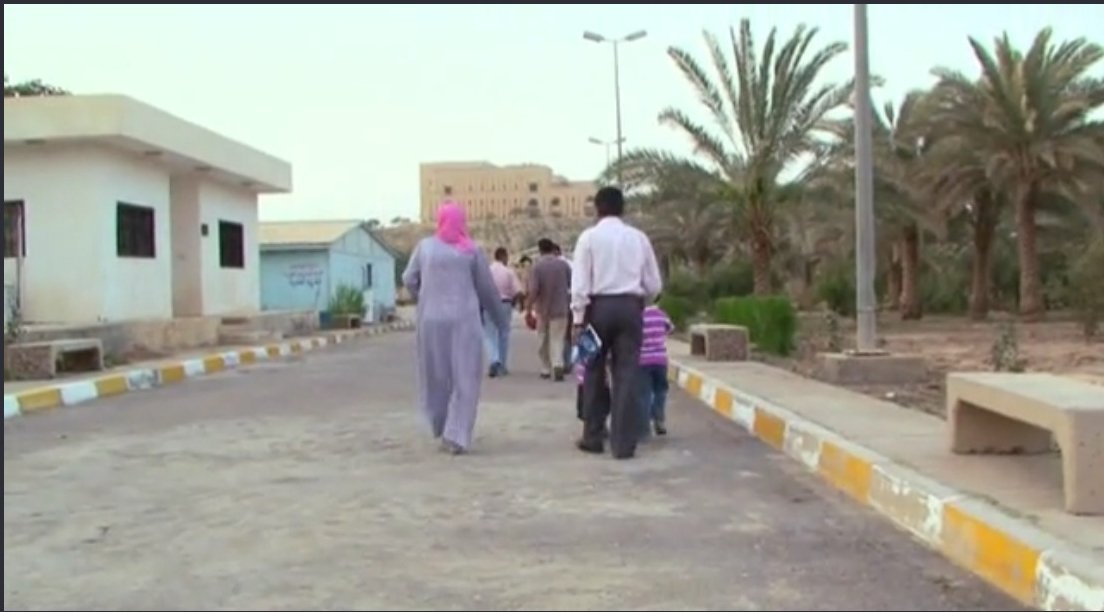
LEFT: A World Monuments Fund Video, in its documentation supporting Babylon as a candidate for a United Nations UNESCO WORLD HERITAGE SITE award, which it received in 2019, made reference to "Local residents living next to the site", showing some of those residents in the Photograph at left.
This agrees with the information in Note #8 below.
Note Babylon's "Saddam Palace and Mountain" straight ahead in the background.
https://www.wmf.org/project/future-babylon
RIGHT: Food Market in Babylon today. The encircled Arabic word on the picture is "Babil". The location is Babylon, which is the source city of its outgrowth city, Hillah, Iraq.
Babylon is located at Hillah. These pictured are residents of Babylon in this Trip Advisor website.
The people shown at this market in Babylon are undoubtedly Iraqi Arabs and Chaldeans.
...and how that fact alone makes it impossible that Babylon, Iraq has yet fulfilled the Biblical prophecies of its Final Fall.

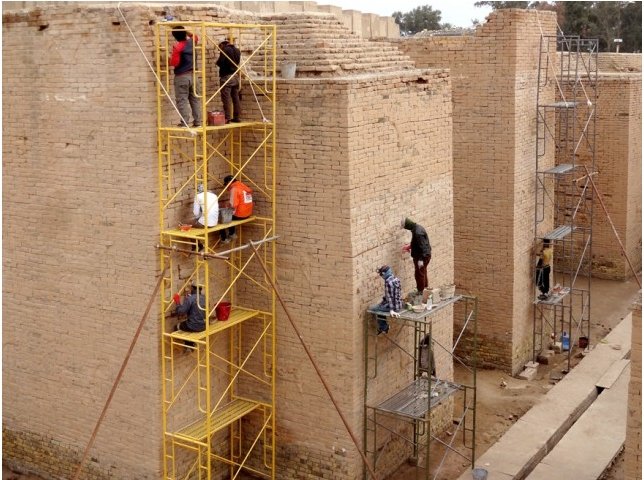
LEFT: Who are these workers at Babylon. Are they,
1. Inhabitants of Babylon?
2. Arabs of Babylon?
3. Visitors-workers to Babylon?
It really makes no difference, for if Babylon of Chaldea has seen its Final Fall in the PAST, then it would be impossible to Photograph any of the above categories (1, 2, or 3).
Yet, the Photograph is a picture of one or more of the above mentioned categories. Read below,
After its Final Fall, Babylon...
...will [ 1 ] never be inhabited or lived in from generation to generation; Nor will the [ 2 ] Arab pitch his tent there...
Her cities ... A land in which no man lives, And [ 3 ] through which no son of man passes. (Isaiah 13:20: Jeremiah 51:43
RIGHT: This bazaar, at least in the years the Polish military was there (2002-2005), was located INSIDE the Inner City Wall of Babylon.
https://mapio.net/a/105616444/?lang=en
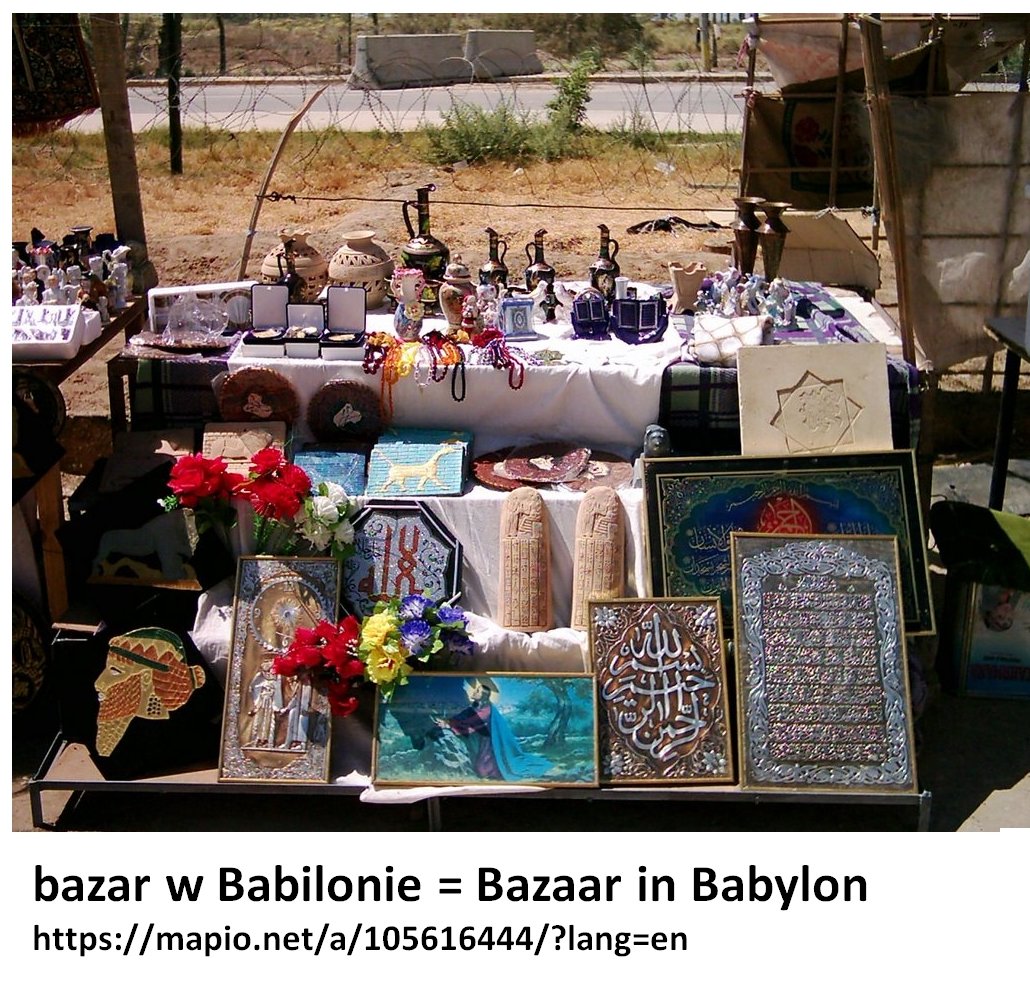
RIGHT: This Polish photo identifies the man as among "Nomads of Babel."
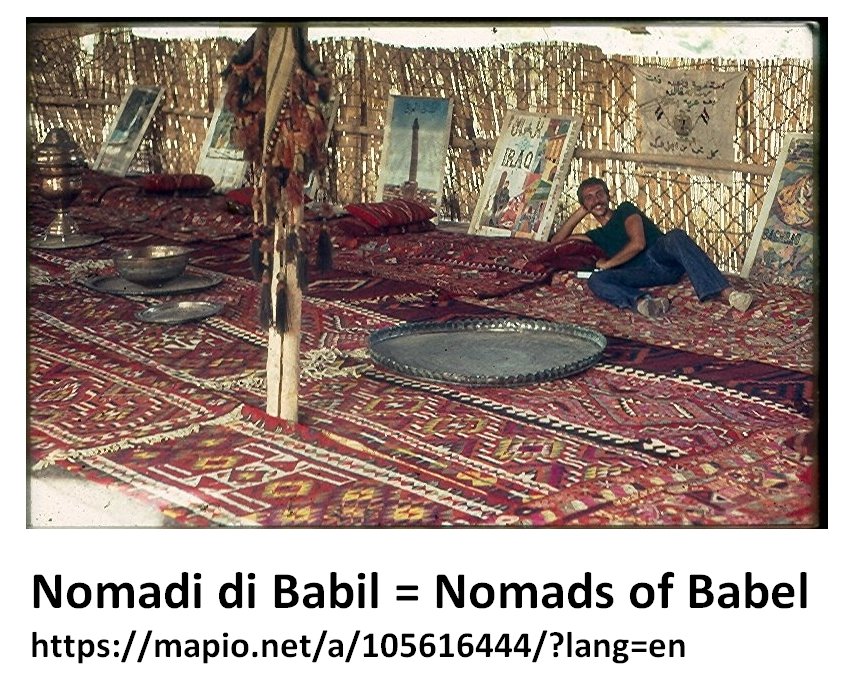
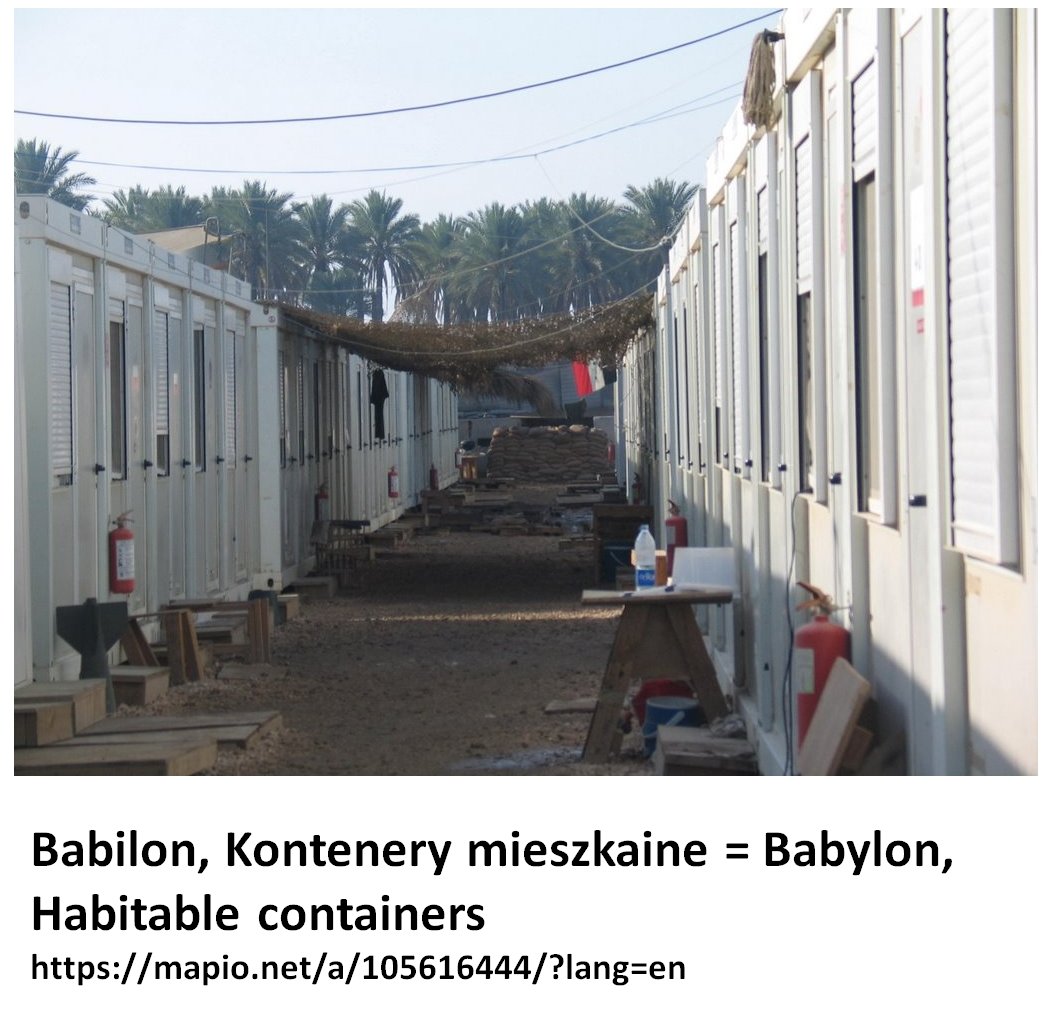
LEFT: A Polish military photo with the caption of "Habitable containers" for their troops who were temporary Inhabitants of Babylon in the early years of this century.
They were located in the very center of Babylon just south of the Saddam Palace near the palace of Nebuchadnezzar.
RIGHT: The Skull Lake Stadium soccer field is 430 feet from the current outer-wall active archaeological digs at Babylon. It sets on Babylon Resort Street which is a main access road through the ruins.
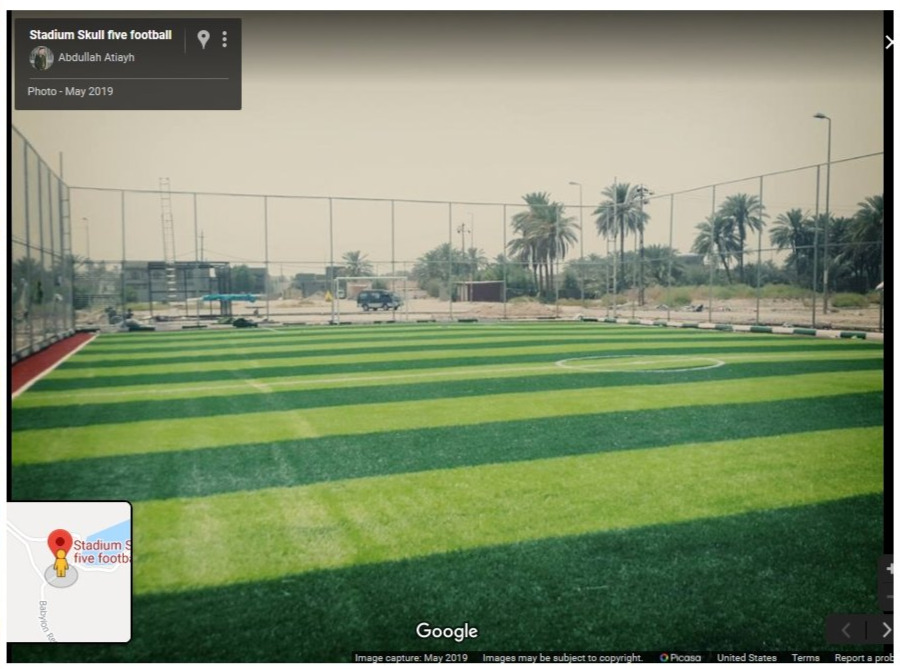
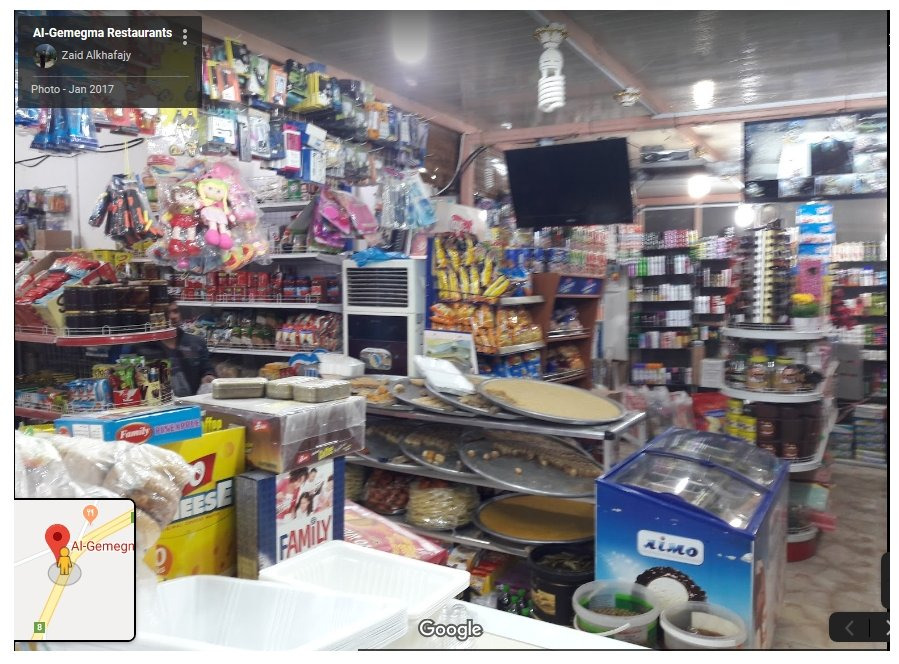
LEFT: The Al-Gemegma Restaurant is 125 feet from and adjacent to the Babylon-site outer wall.
RIGHT: The Black Rivers Restaurant is located within the southeast corner of the active archaeological site of the ancient city of Babylon today.
This is according to its alignment with the outer wall between the two artificial tourist lakes located by the Arab village of Jumjumma and the other to the east
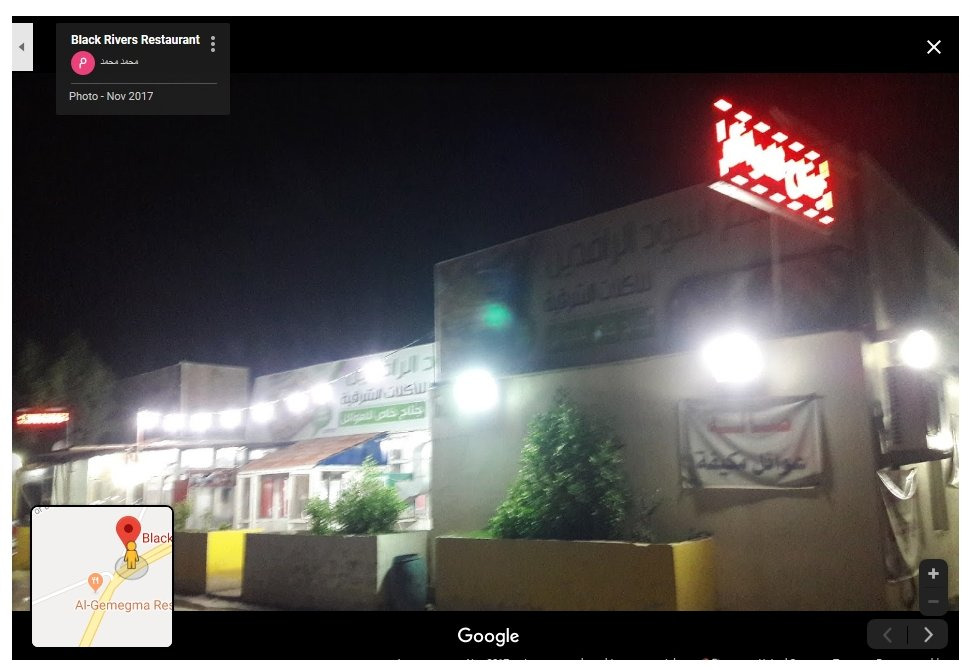
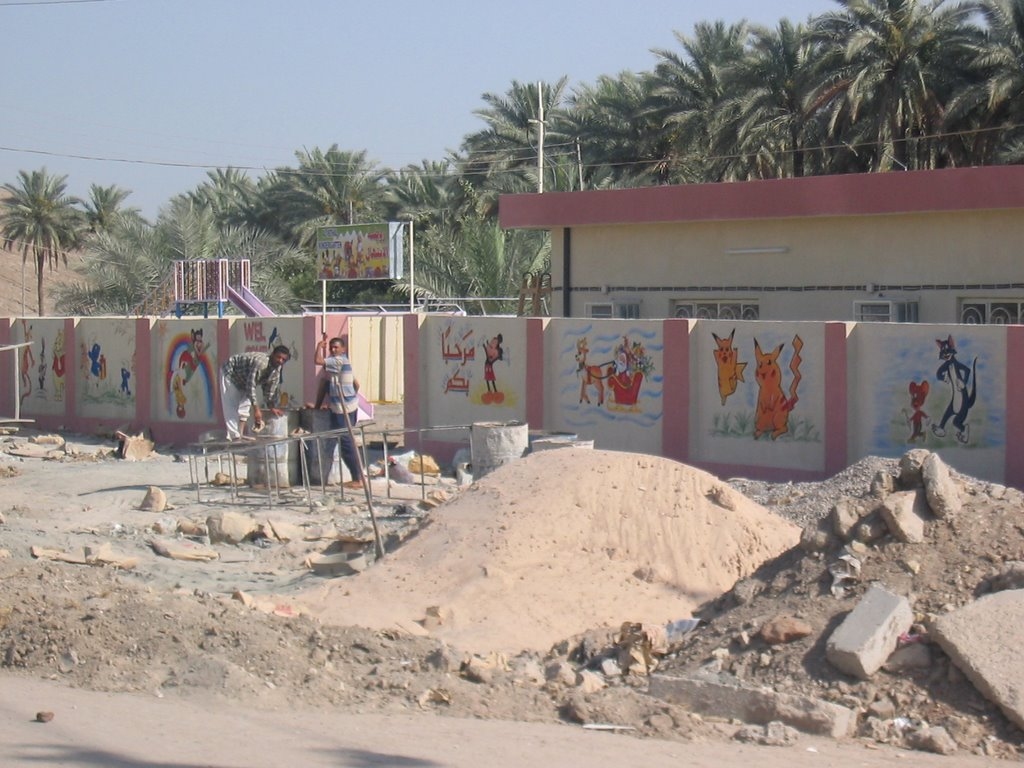
LEFT: Building a new school on the southwestern-most extent of the Babylon grounds near the Arab village of Jumjumma, from the Polish map at...
https://mapio.net/a/105616444/?lang=en
The Polish map also shows an Arabic administered Medical Clinic at approximately the same location.
BELOW: The Graphic shows a brief timeline of people living at Babylon since its fall in 539 BC until today. Basic documentation FOLLOWS.

The Graphic ABOVE shows a basic timeline of people living at Babylon since its fall in 539 BC until today. Basic documentation is BELOW.
Further Down: Read the historical accounts below in the 2500-Year Timeline of the Inhabitants of Babylon AFTER the First Fall of Babylon ... 2
1. (331 BC)--Alexander the Great …wanted Babylon to become the capital of his new empire...There was a Greek-Macedonian presence in Babylon ...a...well preserved theatre in the area...as well as a gymnasium and an agora…
"Babylon“, Gwendolyn Leick, Mesopotamia: The Invention of the City, London, Penguin Books.,2001-02, pp. 271-274.
2.(40 BC)-- Jewish high priest Hyrcanus was taken captive by the king of Parthia, who later “set him free from his bonds, and gave him a habitation at Babylon, where there were Jews in great numbers.” Josephus, Antiquities Of The Jews, 15.2.2.
3. (70 AD -1085 AD)--Babylonian Talmud, commentary on the Jewish law, was created by Jews living in Babylon.
http://www.britannica.com/EBchecked/topic/47713/Babylonian-Talmud
4. (1000s)--Oates noted that the Esagila mound within Babylon's fortified walls reveals that Babylon was occupied down to the 11th century A.D.
Joan Oates. Babylon. [Revised Edition]. London. Thames & Hudson. 1979, 1986, 1994, p.160. ISBN 0-500-27384-7
5. (1829 AD)--British Captain surveys Babylon and produces his map showing Arab Village dwellers living over the ruins of Babylon.
Ground Plan of the Remains at & near Babylon, by Capt. R. Mignan, London,
Published by Colburn & Bentley, New Burlington Street, Oct. 1829.
6. (1900 -1917)--Robert Koldewey, German archaeologist, reports 4 Arabs villages living at Babylon— Kweiresh, Djumdjumma, Sindjar and Ananeh.
Robert Koldewey, The Excavations At Babylon, trans. Agnes S. Johns (London: Macmillan, 1914) p. 11-12.
MODERN DWELLERS AT BABYLON
7. (1979) "On the government’s recommendation, in 1979 the Antiquities Department began a major excavation and restoration project in Babylon [workers lived there]..."
“Babylon Revival” Project: Improvement of the Babylon Site: Babylon; Director: Roberto Parapetti.
8. (2011) "Another of the more dire threats to the site has been unchecked development inside the boundaries of the old city walls, enclosing nearly three square miles. The fund’s project has plotted the old walls on a map, causing trepidation among Iraqis who live along them now. They fear the preservation of Babylon’s ruins will force them from their homes and farmlands..."
New York Times Arts, A Triage to Save the Ruins of Babylon, By STEVEN LEE MYERS, Published: January 2, 2011
http://www.nytimes.com/2011/01/03/arts/03babylon.html?_r=3&ref=arts&
[Project: Improvement of the Babylon Site: Babylon; Director: Roberto Parapetti]
2018— All Remarks below are from The Official Management Plan of Babylon
(Property Nominated by the Government of Iraq in January 2018 for Inscription on the World Heritage List
(in coordination with UNESCO and the WORLD MONUMENTS FUND; p. 51-73)
1. “more than 500 privately owned plots within Babylon’s boundaries “ p. 51-53
2. “Al-Jimjmah – Arab Village on the Grounds of Babylon; Population: 2,500 in the north and 2,800 in the south section, Comprised of about 500 houses“ p. 54-58
3. “Several [Al-Jimjma] residents own plots inside Babylon where farming is forbidden, and still graze livestock on these properties.“ p. 54-58
4. “Sinjar and Zwair – Arab Village on the Grounds of Babylon; “Located within the site boundaries west of the Shatt al-Hillah. Pop: 5,300; At Zwair houses are under construction on the riverbank facing the central archaeological area.“ p. 54-58
5. “Annanah – [Arab Village bordering the Grounds of Babylon] Population: 8,000“
6. “…unregulated livestock grazing and solid waste disposal practices endanger the landscape.” p. 54-58
7. “Free-ranging livestock (belonging to landowners within the site boundaries) tramples archaeological remains.” p. 69
8. “…clan sheikhs and farmers owning property inside the site...” p. 71
9. “People living and farming within the site boundary...” p. 72-73
10. “…private land use within and adjacent to Babylon.” p. 72-73
11. “…Villagers with extended families holding farmland inside the site.” p. 72-73
12. “…private land use within and adjacent to Babylon.” p. 72-73
13. "There are TODAY 500 privately owned plots within & along the walls of Babylon’s boundaries", with a population of more than 11,000 INHABITANTS. The Arab Villages of Sinjar, Zwair, Kweiresh, and JumJumah lie largely within Babylon.
World Monuments Fund Site Management Plan, 2015, p. 51-73.
Inhabitants at Babylon--The PROPHETIC IMPERATIVE
The complete absence of Inhabitants at Babylon has never occurred. Therefore, Babylon's FINAL FALL is yet to happen in the Future.
This is still to happen when a rebuilt Babylon meets its Final Destruction, because the city has never been without some degree of habitation. Remember, the prophecy says that AFTER it's Final Fall Babylon will "never" have people "from generation to generation."
The 2500-year Timeline of Inhabitants at Babylon
NOTES:
return to BABYLON REBUILT main article
1. After the FINAL FALL there will never again be any inhabitants. After its Final Destruction, Babylon of Chaldea, “will never be inhabited or lived in from generation to generation…” (Isa 13:19-20)
BUT WHAT DO WE SEE?...
Major excavations were conducted by the German architect R. Koldewey (1855–1925) from 1899 to 1917. These excavations revealed data for all levels of occupation from Old Babylonian (1894–1595 B.C.E.) to Parthian times (250 B.C.E.–224 C.E.)
http://www.jewishvirtuallibrary.org/jsource/judaica/ejud_0002_0003_0_01806.html
The Talmudic Academies in Babylonia, also known as the Geonic Academies, were the center for Jewish scholarship and the development of Halakha from roughly 589 to 1038 CE
https://en.wikipedia.org/wiki/Talmudic_Academies_in_Babylonia
“Babylon continued to be inhabited in some form or other as late as AD 1000.”
John F. Walvoord, The Nations In Prophecy, Zondervan Publishing House, Grand Rapids, MI, 1967, p.58. (Walvoord believes a rebuilt Babylon is a possibility)
“I can find no time in history when it can be said conclusively that Babylon ceased to exist. Her population has risen and fallen through the ages, but there has never been a time when the city has been completely abandoned... Babylon’s fortunes have declined, but the city has never been destroyed.”
Charles Dyer, The Rise of Babylon. Wheaton, Illinois: Tyndale House, 1991, p.130-131.
Quotation-- World Monuments Fund Video: Makes reference to "Local residents living next to the site"
https://www.wmf.org/project/future-babylon
2. AND MUCH MORE... See the...
